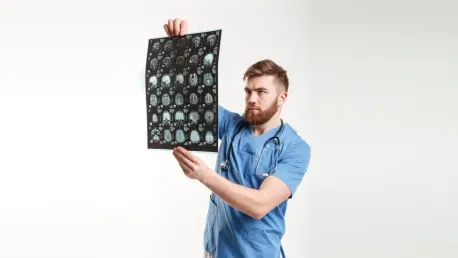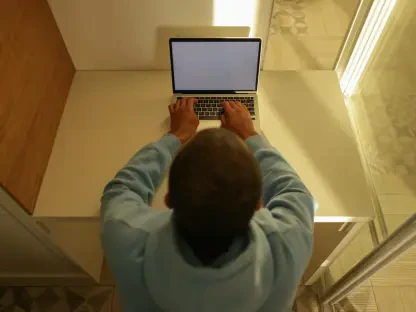In a significant advancement in medical research, scientists have developed a cutting-edge radiomics model that identifies neural changes in Crohn’s disease (CD) patients by leveraging brain MRI features and clinical variables. This innovative model, discussed in a recent publication in Insights Into Imaging, sets a new benchmark by distinguishing healthy individuals from those afflicted with CD and emphasizing brain elements crucial to understanding the interaction between neural well-being and the gut microbiome. The gut-brain axis, a core link between the brain and digestive system, is posited to play a pivotal role in the pathogenesis of CD, underscoring its relevance in managing the disease. Nonetheless, despite recognizing this link, the precise neural changes in CD patients have remained ambiguous, presenting challenges in developing effective treatments, as highlighted by Xue-hua Li from The First Affiliated Hospital of Sun Yat-Sen University, China, and fellow researchers.
Study Methodology and Model Development
Comprehensive Examination of Participants
The study comprised a total of 230 CD patients and 46 healthy participants, each subjected to a range of diagnostic assessments, including brain MRIs, psychological evaluations, blood metabolic tests, and fecal 16S rRNA sequencing. These thorough diagnostic exercises were designed to provide a multidimensional view of the participants’ health, contributing to the robust data set underpinning the research. The information amassed from these diverse tests allowed the researchers to build a radiomics model that combines 13 significant imaging features derived from a dataset exceeding 13,000 individual data points. This substantial dataset enabled the model to effectively discern between healthy controls and individuals with CD based solely on brain imaging data.
Performance of the Radiomics Model
The resultant radiomics model demonstrated remarkable proficiency, with an AUC (Area Under the Curve) of 0.99 during the training phase and 0.95 throughout the testing phase. These results denote the model’s exceptional reliability and predictive power. Integrating multiomics data, which includes gut microbiomics, blood metabolomics, and brain radiomics, unveiled pronounced distinctions between the two groups. This rigorous, high-fidelity approach confirmed the model’s precision in segregating CD patients from healthy control individuals, a significant stride toward understanding and potentially treating the disease more effectively.
New Insights into Neural Changes
Discovery of Novel Imaging Features
One of the most intriguing outcomes of the study is the identification of specific brain imaging features linked with CD that had not been recognized before. While eight of the features corroborate findings from previous studies, five new features emerged as fresh discoveries. These distinctive attributes include lower R2star values in the left hippocampus, a higher KFA in the left caudal anterior cingulate cortex, increased geodesic anisotropy in the right superior-frontal cortex, and heightened cerebral blood flow in both the left middle temporal cortex and the left thalamus. These novel insights offer researchers a deeper understanding of the neuropsychological changes experienced by CD patients, opening new avenues for investigation and therapeutic interventions.
Gut Microbiota and Blood Metabolite Correlation
The study further affirms the theory that changes in gut microbiota and blood metabolites are interconnected with brain alterations in CD patients via the gut-brain axis. Correlations were found between blood metabolites enriched in CD patients, such as triacylglycerol, and the distinct brain imaging features that were identified. These findings validate earlier clinical and preclinical studies, suggesting that therapies targeting the brain-gut axis could be effective in ameliorating intestinal lesions and improving clinical markers in CD patients. Such correlations underscore the importance of a holistic approach to understanding and treating CD, encompassing the intricate interplay between various bodily systems.
Implications for Future Research and Treatment
Potential for Targeted Therapies
This groundbreaking research opens up promising possibilities for the development of targeted therapies for CD patients. By elucidating the connections between neural health and the gut microbiome, the study paves the way for more precise and personalized treatment strategies. Utilizing the insights gained from the radiomics model and the identified brain imaging features, medical professionals can better predict and monitor the progression of CD in patients. These advancements could lead to the formulation of new treatment protocols that specifically address the underlying neural alterations associated with the disease.
Broadening the Scope of Research
The study involved 230 individuals diagnosed with Crohn’s disease (CD) and 46 healthy participants, all of whom underwent various diagnostic procedures. These assessments included brain MRIs, psychological evaluations, blood metabolic tests, and fecal 16S rRNA sequencing. The comprehensive nature of these diagnostic tests aimed to offer a well-rounded view of the participants’ health, forming a solid foundation for the research. The data collected from these examinations enabled the development of a radiomics model. This model integrates 13 key imaging features derived from an exhaustive dataset that exceeds 13,000 data points. This extensive dataset empowered the radiomics model to accurately differentiate between healthy individuals and those suffering from CD using only brain imaging data. The robust approach of combining multimodal diagnostic tools significantly enhances the reliability and precision of the study’s findings, setting a precedent for future research in the field of CD and other similar disorders.









